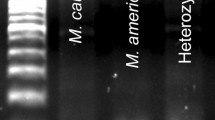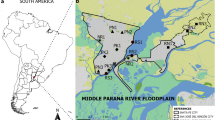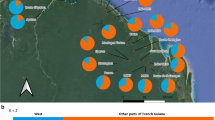Abstract
Urban development is a major cause of habitat loss and fragmentation. Few studies, however, have dealt with fragmentation in an urban landscape. In this paper, we examine the genetic structure of isolated populations of the eastern red-backed salamander (Plethodon cinereus) in a metropolitan area. We sampled four populations located on a mountain in the heart of Montréal (Québec, Canada), which presents a mosaic of forested patches isolated by roads, graveyards and buildings. We assessed the genetic structure of these populations using microsatellite loci and compared it to the genetic structure of four populations located in a continuous habitat in southern Québec. Our results indicate that allelic richness and heterozygosity are lower in the urban populations. Exact differentiation tests and pairwise F ST also show that the populations found in the fragmented habitat are genetically differentiated, whereas populations located in the continuous habitat are genetically homogeneous. These results raise conservation concerns for these populations as well as for rare or threatened species inhabiting urban landscapes.

Similar content being viewed by others
References
Adams FD (1903) The Monteregian Hills – a Canadian petrographical province. J Geol 2:239–282
Andersen LW, Fog K, Damgaard C (2004) Habitat fragmentation causes bottlenecks and inbreeding in the European tree frog (Hyla arborea). Proc Biol Sci 271:1293–1302
Beebee TJC, Flower RJ, Stevenson AC, Patrick ST, Appleby PG, Fletcher C, Marsh C, Natkanski J, Rippey B, Battarbee RW (1990) Decline of the natterjack toad Bufo calamita in Britain: paleoecological, documentary and experimental evidence for breeding site acidification. Biol Conserv 53:1–20
Berger L, Speare R, Daszak P, Green DE, Cunningham AA, Goggin CL, Slocombe R, Ragan MA, Hyatt AD, McDonald KR, Hines HB, Lips KR, Marantelli G, Parkes H (1998) Chytridiomycosis causes amphibian mortality associated with population declines in the rain forests of Australia and Central America. Proc Natl Acad Sci USA 95:9031–9036
Berry O, Tocher MD, Sarre SD (2004) Can assignment tests measure dispersal? Mol Ecol 13:551–561
Blaustein AR, Kiesecker JM, Chivers DP, Hokit DG, Marco A, Belden LK, Hatch A (1998) Effects of ultraviolet radiation on amphibians: field experiments. Am Zool 38:799–812
Bonin J, Desroches J-F, Ouellet M, Leduc A (1999) Les forêts anciennes: refuges pour les salamandres. Nat Can 123(1):13–18
Brown JL (1965) Stability of color phase ratio in populations of Plethodon cinereus. Copeia 1965:95–98
Burton TM, Likens GE (1975) Salamander populations and biomass in the Hubbard Brook Experimental Forest, New Hampshire. Copeia 1975:541–546
Connors LM, Cabe PR (2003) Isolation of dinucleotide microsatellite loci from red-backed salamander (Plethodon cinereus). Mol Ecol Notes 3:131–133
Czech B, Krausman PR, Devers PK (2000) Economic associations among causes of species endangerment in the United States. BioScience 50:593–601
deMaynadier PG, Hunter Jr ML (1998) Effects of sylvicultural edges on the distribution and abundance of amphibians in Maine. Conserv Biol 12:340–352
Dodd Jr CK, Smith LL (2003) Habitat destruction and alteration: historical trends and future prospects for amphibians. In: Semlitsch RD (ed) Amphibian conservation. Smithsonian Institution, Washington, DC, pp 94–112
Dyrkacz S (1981) Recent instances of albinism in North American amphibians and reptiles. Society for the Study of Amphibians and Reptiles Herpetological Circular No. 11
Ehman H, Cogger H (1985) Australia’s endangered herpetofauna: a review of criteria and policies. In: Grigg GC, Shine R, Ehmann HFW (eds) Biology of Australasian frogs and reptiles. Royal Zoological Society of New South Wales, Sydney, pp 435–447
Excoffier L, Smouse PE, Quattro JM (1992) Analysis of molecular variance inferred from metric distances among DNA haplotypes: application to human mitochondrial DNA restriction data. Genetics 131:479–491
Fahrig L (2003) Effects of habitat fragmentation on biodiversity. Ann Rev Ecol Syst 34:487–515
Fahrig L, Pedlar JH, Pope SE, Taylor PD, Wegner JF (1995) Effect of road traffic on amphibian density. Biol Conserv 73:177–182
Forman RTT, Alexander LE (1998) Roads and their major ecological effects. Ann Rev Ecol Syst 29:207–231
Frankham R (1996) Relationship of genetic variation to population size in wildlife. Conserv Biol 10:1500–1508
Gibbs JP (1998a) Distribution of woodland amphibians along a forest fragmentation gradient. Landsc Ecol 13:263–268
Gibbs JP (1998b) Genetic structure of redback salamander Plethodon cinereus populations in continuous and fragmented forests. Biol Conserv 86:77–81
Goudet J (2002) FSTAT, a software to estimate and test gene diversities and differentiation statistics from codominant markers (version 2.9.3.2). Available from http://www2.unil.ch/popgen/softwares/fstat.htm
Green DM (1997) Perspectives on amphibian population declines: defining the problem and searching for answers. Herpetol Conserv 1:291–308
Greer AEJ (1973) Adaptative significance of the color phases of the red-backed salamander. Yearb Am Philos Soc 1973:308–309
Grover MC (1998) Influence of cover and moisture on abundances of the terrestrial salamanders Plethodon cinereus and Plethodon glutinosus. J Herpetol 32:489–497
Highton R (1959) The inheritance of the color phases of Plethodon cinereus. Copeia 1959:33–37
Highton R (1977) Comparison of microgeographic variation in morphological and electrophoretic traits. In: Hecht M, Steer W, Wallace B (eds) Evolutionary biology. Plenum Publishing, New York, pp 397–436
Highton R, Webster TP (1976) Geographic protein variation and divergence in populations of the salamander Plethodon cinereus. Evolution 30:33–45
Hitchings SP, Beebee TJC (1997) Genetic substructuring as a result of barriers to gene flow in urban Rana temporaria (common frog) populations: implications for biodiversity conservation. Heredity 79:117–127
Hitchings SP, Beebee TJC (1998) Loss of genetic diversity and fitness in common toad (Bufo bufo) populations isolated by inimical habitat. J Evol Biol 11:269–283
Houlahan JE, Findlay CS, Schmidt BR, Meyer AH, Kuzmin SL (2000) Quantitative evidence for global amphibian population declines. Nature 404:752–755
Hyde EJ, Simons TR (2001) Sampling plethodontid salamanders: sources of variability. J Wildl Manage 65:624–632
Jaeger RG (1979) Seasonal spatial distributions of the terrestrial salamander Plethodon cinereus. Herpetologica 35:90–93
Kimberling DN, Ferreira AR, Shuster SM, Keim P (1996) RAPD marker estimation of genetic structure among isolated northern leopard frog populations in the south-western USA. Mol Ecol 5:521–529
Kleeberger SR, Werner JK (1982) Home range and homing behavior of Plethodon cinereus in northern Michigan. Copeia 1982:409–415
Knapp RA, Matthews KR (2000) Non-native fish introductions and the decline of the mountain yellow-legged frog from within protected areas. Conserv Biol 14:428–438
Kolozsvary MB, Swihart RK (1999) Habitat fragmentation and the distribution of amphibians: patch and landscape correlates in farmland. Can J Zool 77:1288–1299
Kucken DJ, Davis JS, Petranka JW, Smith CK (1994) Anakeesta stream acidification and metal contamination-effects on a salamander community. J Environ Qual 23:1311–1317
Kuhn J (1987) Strabentod der Erdkrote (Bufo bufo L.) Verlustquoten und Verkehrsaufkommen, Verhalten auf der Straße. Beiheft Veroffentlichungen Naturschutz Landschaftspflege Baden-Wurttemberg 41:175–176
Lacy R (1987) Loss of genetic diversity from managed populations: interacting effects of drift, mutation, immigration, selection, and population subdivision. Conserv Biol 1:143–158
Larson A, Wake DB, Yanev KP (1984) Measuring gene flow among populations having high-levels of genetic fragmentation. Genetics 106:293–308
Lotter F, Scott Jr NJ (1977) Correlation between climate and distribution of the color morphs of the salamander Plethodon cinereus. Copeia 1977:681–690
Marsh DM, Beckman NG (2004) Effects of forest roads on the abundance and activity of terrestrial salamanders. Ecol Appl 14:1882–1891
Marsh DM, Thakur KA, Bulka KC, Clarke LB (2004) Dispersal and colonization through open fields by a terrestrial, woodland salamander. Ecology 85:3396–3405
Miller JR, Hobbs RJ (2002) Conservation where people live and work. Conserv Biol 16:330–337
Muralidharan K, Wakeland EK (1993) Concentration of primer and template qualitatively affects products in random-amplified polymorphic DNA PCR. Biotechniques 14:362–364
Murphy NR, Hellwig RJ (1996) Improved nucleic acid organic extraction through use of a unique gel barrier material. Biotechniques 21:934–936
Ouellet M, Galois P, Pétel R, Fortin C (2005a) Les amphibiens et les reptiles des collines montérégiennes: enjeux et conservation. Nat Can 129(1):42–49
Ouellet M, Mikaelian I, Pauli BD, Rodrigue J, Green DM (2005b) Historical evidence of widespread chytrid infection in North American amphibian populations. Conserv Biol 19:1431–1440
Pabijan M, Babik W, Rafinski J (2005) Conservation units in north-eastern populations of the Alpine newt (Triturus alpestris). Conserv Genet 6:307–312
Petit RJ, El Mousadik A, Pons O (1998) Identifying populations for conservation on the basis of genetic markers. Conserv Biol 12:844–855
Petranka J (1998) Salamanders of the United States and Canada. Smithsonian Institution, Washington, DC
Pfingsten RA, Walker CF (1978) Some nearly all black populations of Plethodon cinereus (Amphibia, Urodela, Plethodontidae) in northern Ohio. J Herpetol 12:163–167
Piry S, Alapetite A, Cornuet J-M., Paetkau D, Baudouin L, Estoup A (2004) GeneClass2: a software for genetic assignment and first generation migrants detection. J Hered 95:536–539
Pounds JA, Fogden MPL, Campbell JH (1999) Biological response to climate change on a tropical mountain. Nature 398:611–615
Rannala B, Mountain JL (1997) Detecting immigration by using multilocus genotypes. Proc Nat Acad Sci USA 94:9197–9201
Raymond M, Rousset F (1995) Genepop (Version 1.2): population genetics software for exact tests and ecumenicism. J Hered 86:248–249
Reed DH, Frankham R (2003) Correlation between fitness and genetic diversity. Conserv Biol 17:230–237
Reed DH, Hobbs GR (2004) The relationship between population size and temporal variability in population size. Anim Conserv 7:1–8
Reed HD (1908) A note on the coloration of Plethodon cinereus. Am Nat 42:460–465
Rice WR (1989) Analyzing tables of statistical tests. Evolution 43:223–225
Rieseberg LH (1996) Homology among RAPD fragments in interspecific comparisons. Mol Ecol 5:99–105
Rosen M (1971) An erythristic Plethodon cinereus cinereus from Ste Foy, Portneuf county, Québec. Can Field-Nat 85:326–327
Sambrook J, Fritsch EF, Maniatis T (1989) Molecular cloning: a laboratory manual, 2nd edn. Cold Spring Harbor Laboratory Press, Cold Spring Harbor
Schierwater B, Ender A (1993) Different thermostable DNA-polymerases may amplify different RAPD products. Nucleic Acids Res 21:4647–4648
Schneider S, Roessli D, Excoffier L (2000) Arlequin: a software for population genetics data analysis. Department of Anthropology, University of Geneva, Geneva
Statistics Canada (2000) Human activity and the environment. Report 11-509-F. Statistics Canada, Ottawa
Tait CJ, Daniels CB, Hill RS (2005) Changes in species assemblages within the Adelaide Metropolitan Area, Australia, 1836–2002. Ecol Appl 15:346–359
Thurow G (1961) A salamander color variant associated with glacial boundaries. Evolution 15:281–287
United Nations Population Division (2004) World urbanization prospects: the 2003 revision. United Nations Department of Economic and Social Affairs, New York
Vos CC, Antonisse-De Jong AG, Goedhart PW, Smulders MJM (2001) Genetic similarity as a measure for connectivity between fragmented populations of the moor frog (Rana arvalis). Heredity 86:598–608
Wasser PM, Strobeck C (1998) Genetic signatures of interpopulation dispersal. Trends Ecol Evol 13:43–44
Welsh J, McClelland M (1990) Fingerprinting genomes using PCR with arbitrary primers. Nucleic Acids Res 18:7213–7218
Wilcove DS, McLellan CH, Dobson AP (1986) Habitat fragmentation in the temperate zone. In: Soulé ME (ed) Conservation biology. Sinauer, Sunderland, pp 237–256
Williams JGK, Kubelik AR, Livak KJ, Rafalski JA, Tingey SV (1990) DNA polymorphisms amplified by arbitrary primers are useful as genetic markers. Nucleic Acids Res 18:6531–6535
Young A, Boyle T, Brown T (1996) The population genetic consequences of habitat fragmentation for plants. Trends Ecol Evol 11:413–418
Zeisset I, Beebee TJC (2003) Population genetics of a successful invader: the marsh frog Rana ridibunda in Britain. Mol Ecol 12:639–646
Acknowledgements
We would like to thank D. Fournier, P. Graillon, S. Marquis, M.-J. Morin, R. Pétel, É. Richard and N. Tessier for their contribution to this study and all members of the Laboratoire d’Écologie Moléculaire et Évolution for their comments on an earlier draft of this manuscript. This study was supported by the Direction des sports, des parcs et des espaces verts de la Ville de Montréal, the Parc national du Mont-Mégantic, Amphibia-Nature, a NSERC scholarship to S. Noël and NSERC grant no. 0155251 to F.-J. Lapointe. Our sampling protocol was approved by the Comité de déontologie de l’expérimentation des animaux of the Université de Montréal.
Author information
Authors and Affiliations
Corresponding author
Rights and permissions
About this article
Cite this article
Noël, S., Ouellet, M., Galois, P. et al. Impact of urban fragmentation on the genetic structure of the eastern red-backed salamander. Conserv Genet 8, 599–606 (2007). https://doi.org/10.1007/s10592-006-9202-1
Received:
Accepted:
Published:
Issue Date:
DOI: https://doi.org/10.1007/s10592-006-9202-1




